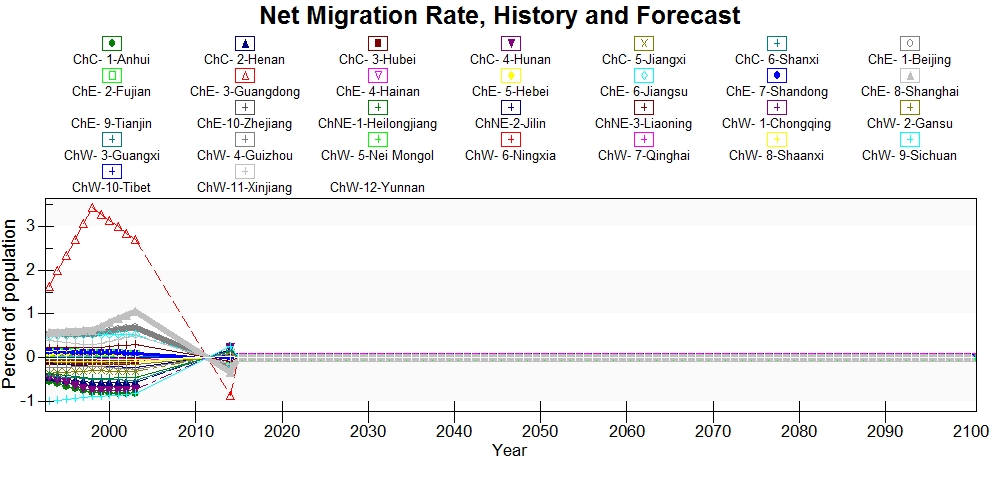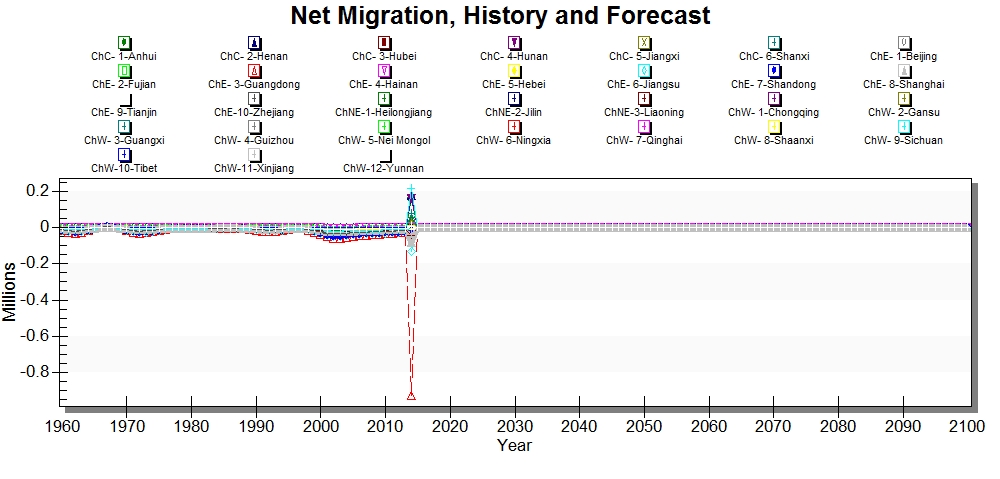China's Provincial ForecastNetMigrationRate UNPD: Difference between revisions
AltheaDitter (talk | contribs) No edit summary |
AltheaDitter (talk | contribs) No edit summary |
||
| Line 3: | Line 3: | ||
This series should be treated as a placeholder, not as a legitimate series. Further research is required to reproduce the data from the paper using the paper's methodology. The paper's appendices need to used to locate the original data sources for all the data and for understanding the methods used for estimation. This series should be replicated and hypothetically there may be an update available, which would give the model more recent data. | This series should be treated as a placeholder, not as a legitimate series. Further research is required to reproduce the data from the paper using the paper's methodology. The paper's appendices need to used to locate the original data sources for all the data and for understanding the methods used for estimation. This series should be replicated and hypothetically there may be an update available, which would give the model more recent data. | ||
[[File:NetMigrationRate v728.jpg]] | [[File:NetMigrationRate v728.jpg|RTENOTITLE]] | ||
It is apparent that the way in which the model estimates migration by using exogenous data from the UNPD | It is apparent that the way in which the model estimates migration by using exogenous historical and forecast data from the UNPD, that having historical data is insufficient for the model to produce good forecasts. Rather the model will force all provinces to a rate of zero. Despite this model behavior, the sum of the province's population forecasts is quite close to the full 186-model forecasts. | ||
[[File:NeMigration v728.jpg]] | |||
Interprovincial migration is a major issue in China due to the mass rural-urban migration that has occured over the last few decades. Measuring interprovincial migration proves to be difficult in all subnational models, simply because the data is frequently unavailable. In China there is a system to control migration that requires households to register as a means to gain access to services. The system also restricts migration by refusing certain rural households the ability to migrate to different provinces legally. This system creates a large amount of data tracking migration, but this data has not been found publicly, only alluded to. Also, an unintended consequence of this system is that there is a great deal of illegal migration among the restricted households. Municipalities, such as Beijing, have a substantial migrant worker population which throws off the model's ability to realistically forecast population and age-sex cohorts. Thus, PopMigration is an important series for the China Provincial Model. Tthe national migration registry data is, thus far, inaccessible and it is undoubtedly inaccurate because it does not account for the substantial illegal interprovincial migration. | Interprovincial migration is a major issue in China due to the mass rural-urban migration that has occured over the last few decades. Measuring interprovincial migration proves to be difficult in all subnational models, simply because the data is frequently unavailable. In China there is a system to control migration that requires households to register as a means to gain access to services. The system also restricts migration by refusing certain rural households the ability to migrate to different provinces legally. This system creates a large amount of data tracking migration, but this data has not been found publicly, only alluded to. Also, an unintended consequence of this system is that there is a great deal of illegal migration among the restricted households. Municipalities, such as Beijing, have a substantial migrant worker population which throws off the model's ability to realistically forecast population and age-sex cohorts. Thus, PopMigration is an important series for the China Provincial Model. Tthe national migration registry data is, thus far, inaccessible and it is undoubtedly inaccurate because it does not account for the substantial illegal interprovincial migration. | ||
Revision as of 20:36, 14 April 2017
The current data series in use comes from a paper out of the University of Washington. The authors used a variety of data sources to estimate interprovincial migration. This data was compiled and published as five-year averages of net migration rates. Because this series is an annualized series, the annual net migration rates were estimated through a simple multi-step process. First the five-year averages were assigned as the middle year value for the annualized data. For instance, if the observation for Anhui province was -0.5 for 1995-2000 then -0.5 was assigned to 1998. The data was then interpolated between the observations to produce annualized data for a fifteen year span.
This series should be treated as a placeholder, not as a legitimate series. Further research is required to reproduce the data from the paper using the paper's methodology. The paper's appendices need to used to locate the original data sources for all the data and for understanding the methods used for estimation. This series should be replicated and hypothetically there may be an update available, which would give the model more recent data.
It is apparent that the way in which the model estimates migration by using exogenous historical and forecast data from the UNPD, that having historical data is insufficient for the model to produce good forecasts. Rather the model will force all provinces to a rate of zero. Despite this model behavior, the sum of the province's population forecasts is quite close to the full 186-model forecasts.
Interprovincial migration is a major issue in China due to the mass rural-urban migration that has occured over the last few decades. Measuring interprovincial migration proves to be difficult in all subnational models, simply because the data is frequently unavailable. In China there is a system to control migration that requires households to register as a means to gain access to services. The system also restricts migration by refusing certain rural households the ability to migrate to different provinces legally. This system creates a large amount of data tracking migration, but this data has not been found publicly, only alluded to. Also, an unintended consequence of this system is that there is a great deal of illegal migration among the restricted households. Municipalities, such as Beijing, have a substantial migrant worker population which throws off the model's ability to realistically forecast population and age-sex cohorts. Thus, PopMigration is an important series for the China Provincial Model. Tthe national migration registry data is, thus far, inaccessible and it is undoubtedly inaccurate because it does not account for the substantial illegal interprovincial migration.

